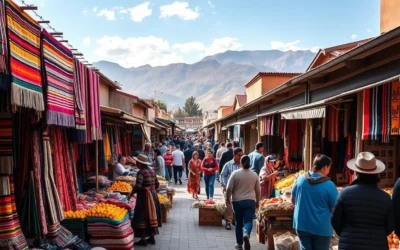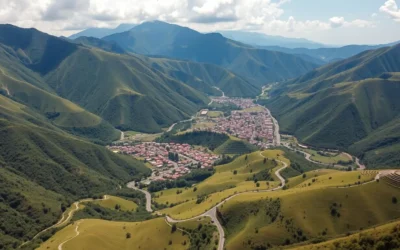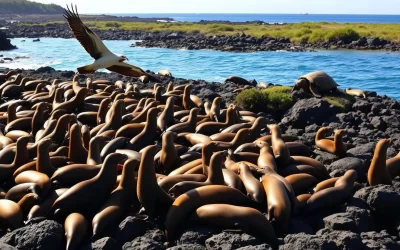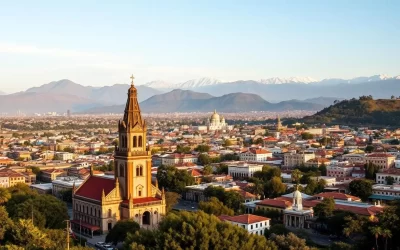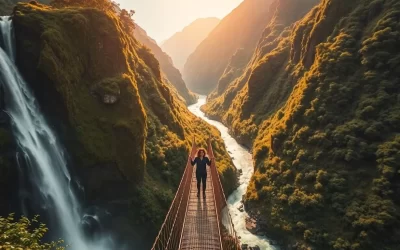You’re about to explore one of Ecuador’s most beautiful city destinations. Known for its charming colonial streets and stunning architecture, this city has earned a special nickname – “the Athens of Ecuador.” This reflects its rich cultural heritage and artistic flair, making it a delightful destination for visitors.
As you wander through the cobblestone streets of the Historic Center, a UNESCO World Heritage Site, you’ll discover a treasure trove of experiences. From historic sites and museums to natural wonders and culinary delights, there’s no shortage of things to see and do. This comprehensive guide will walk you through the best things to do, helping you make the most of your visit to this Ecuadorian gem.
Discovering Cuenca: Ecuador’s Cultural Gem
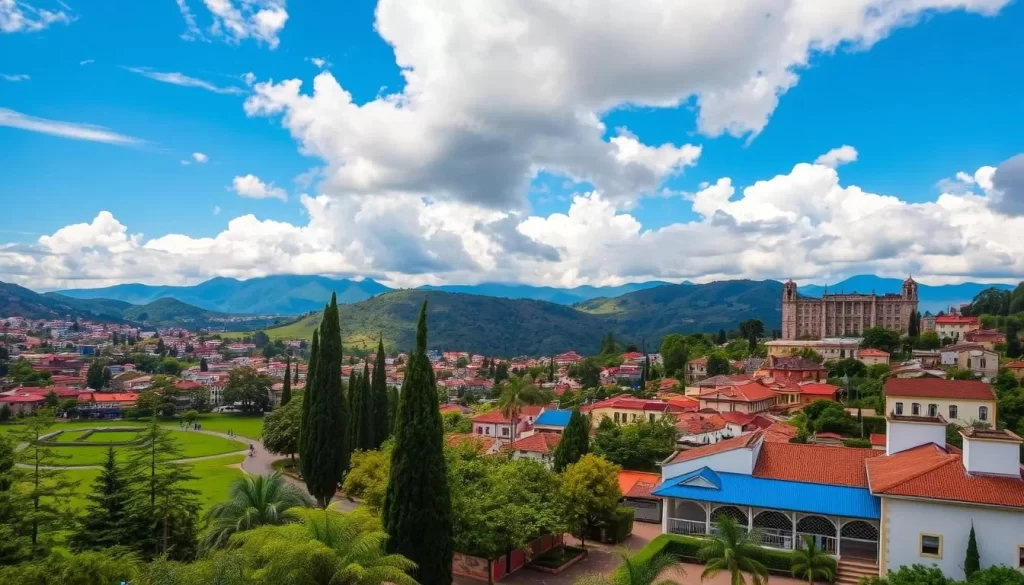
As you step into Cuenca, you’re immediately enveloped in the city’s unique blend of history, art, and tradition. Cuenca, Ecuador, is a city that truly offers something for everyone. Whether you’re seeking breathtaking natural scenery, historical landmarks, or a vibrant nightlife scene, Cuenca has it all.
Why Cuenca Is a Must-Visit Destination
Cuenca stands out as Ecuador’s cultural capital, where you can immerse yourself in a rich tapestry of history, art, and tradition that spans centuries. The city’s UNESCO-recognized historic center features cobblestone streets, colonial buildings, and impressive religious structures that transport you back in time. Cuenca’s elevation of 2,550 meters (8,366 feet) creates a stunning natural backdrop with year-round spring-like weather, making exploring comfortable in any season.
Best Time to Visit Cuenca
The best time to visit Cuenca is during the dry season from June to August when you’ll experience cooler temperatures and less rainfall. Though the city enjoys a relatively mild climate year-round, be aware that February through April tends to be rainier, though still pleasant with sunny periods. Cuenca’s elevation may cause altitude sickness for some travelers, so consider taking it easy during your first day to allow your body to acclimate properly.
Cuenca is also known for being one of the most affordable places to live in Ecuador, making it an excellent choice for ex-pats seeking a quality of life that’s hard to find elsewhere in South America. The city’s compact size makes it easy to explore on foot, allowing you to discover hidden gems and appreciate the architectural details that make Cuenca a photographer’s paradise.
Exploring Cuenca’s Historic Center
Walking through Cuenca’s Historic Center feels like stepping into a living museum. The city’s layout, originally designed by Spanish King Charles V in the 16th century, has remained intact, making it one of Ecuador’s most impressive UNESCO World Heritage Sites.
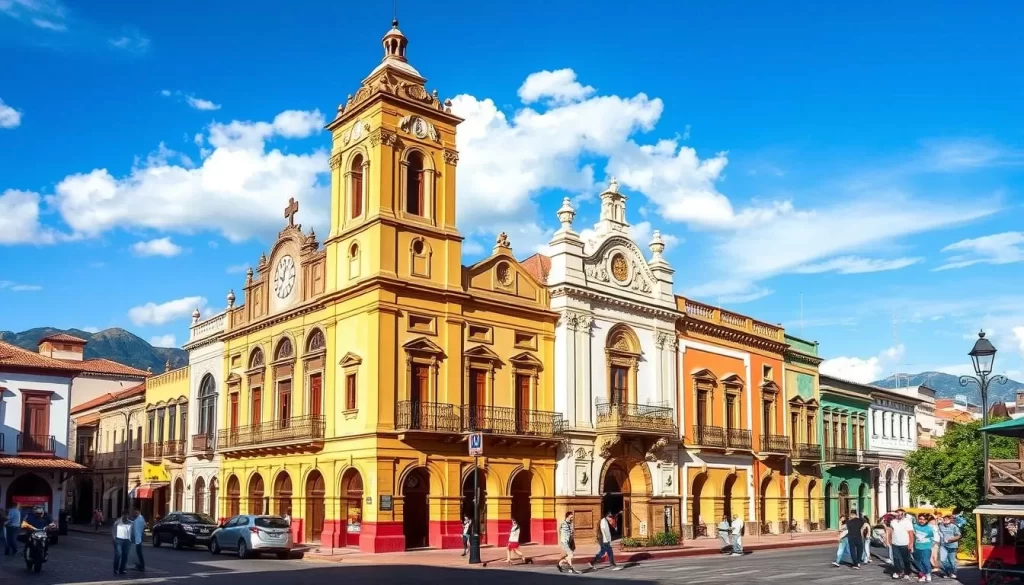
Parque Calderón: The Heart of Cuenca
At the heart of Cuenca’s Historic Center lies Parque Calderón, a vibrant plaza surrounded by significant buildings and adorned with over 2,000 plant species. This lush urban space is where locals and visitors gather to enjoy the serene atmosphere amidst the bustling city.
New Cathedral of Cuenca
The New Cathedral, or Catedral de la Inmaculada Concepción, is Cuenca’s most iconic landmark, distinguished by its three pastel blue domes. For just $2, you can climb the tower to enjoy panoramic views of the city and surrounding mountains. Inside, the cathedral boasts intricate details such as marble floors and a gold-leaf-covered altar.
Old Cathedral (Iglesia El Sagrario)
Across from the New Cathedral stands the Old Cathedral, dating back to 1557. Although no longer in use, it offers a glimpse into Cuenca’s past through a self-guided audio tour that includes access to underground tombs. This historical site provides a unique insight into the city’s rich history and architectural heritage.
The Historic Center’s grid layout makes it easy to explore on foot, discovering hidden plazas, museums, and shops along cobblestone streets that have remained largely unchanged for centuries. As you wander, you’ll notice the distinctive colonial architecture featuring whitewashed buildings with wrought-iron balconies and red-tiled roofs.
Stunning Viewpoints in Cuenca
To truly experience Cuenca, you need to see it from its most stunning viewpoints. The city offers several vantage points that showcase its colonial architecture, grid-pattern streets, and picturesque surroundings.
Mirador de Turi: Panoramic City Views
Mirador de Turi is one of Cuenca’s most celebrated viewpoints, offering panoramic views of the city from its elevated position on a hillside south of the city center. You can appreciate the full layout of the colonial city against its mountain backdrop.
You can reach Mirador de Turi by taking a challenging uphill walk or by catching a quick 10-15 minute taxi ride from the city center. The viewpoint is particularly magical at sunset when both locals and visitors gather to watch the sun dip behind the Andes mountains.
Cathedral Towers Viewpoint
The Cathedral Towers Viewpoint provides a completely different perspective of Cuenca from the heart of the historic center. For just $2, you can climb the towers of the New Cathedral for 360-degree views.
From the Cathedral Towers, you’ll get an up-close look at the iconic blue domes and a bird’s-eye view of Parque Calderón and the surrounding colonial architecture. This viewpoint is an excellent spot for photography, allowing you to capture the unique layout of Cuenca.
Museums and Cultural Sites
Visitors to Cuenca can immerse themselves in the city’s rich cultural heritage by visiting its many museums and cultural attractions. Cuenca is home to a variety of cultural institutions that showcase the city’s history, art, and natural beauty.
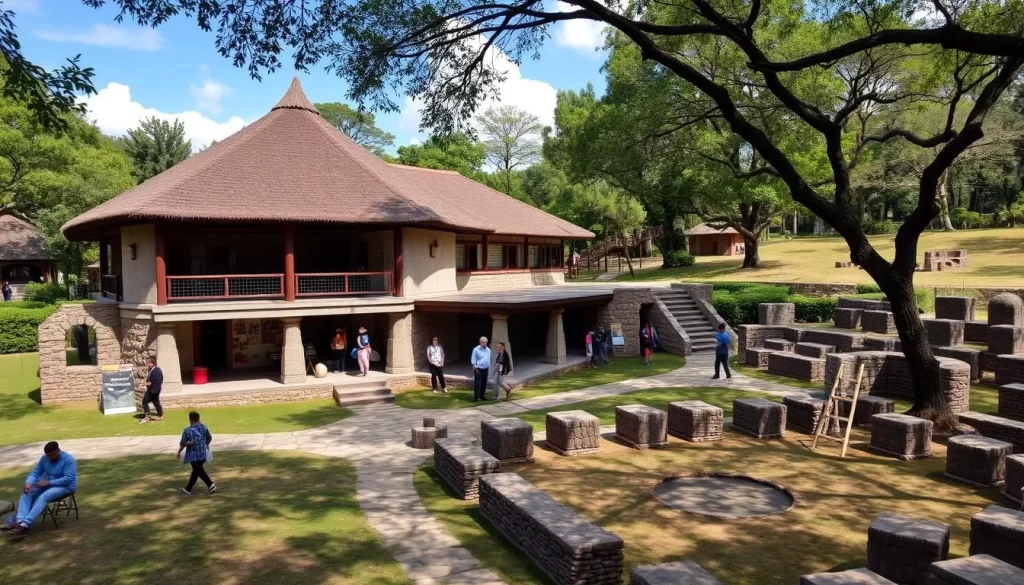
Pumapungo Museum and Archaeological Park
The Pumapungo Museum and Archaeological Park is a must-visit cultural complex managed by Ecuador’s Ministry of Culture and Heritage. It offers a comprehensive cultural experience, featuring a museum and the Pumapungo Ancestral Park. The museum has diverse collections, including traditional clothing, religious artifacts, and exhibits on the history of Ecuador’s currency.
The archaeological park contains Inca ruins, including foundations, terraces, and a canal system, showcasing the advanced engineering skills of the Inca civilization. The site also features beautiful botanical gardens and an aviary with native bird species.
CIDAP Museum
The CIDAP Museum, or Inter-American Center for Crafts and Popular Arts, is another significant cultural institution in Cuenca. It showcases exquisite handmade items from South America, including woodwork, pottery, textiles, and jewelry crafted by master artisans. CIDAP hosts special exhibitions throughout the year, with the annual Fiestas Mercado in November being a highlight.
Museum of Aboriginal Cultures
The Museum of Aboriginal Cultures provides insight into Ecuador’s pre-Columbian past with artifacts and educational displays. It helps visitors understand the rich cultural heritage of the region’s indigenous peoples. This museum, along with Pumapungo and CIDAP, offers a deep dive into Ecuador’s cultural identity, from ancient civilizations to contemporary artistic expressions.
These museums collectively offer a rich cultural experience, making Cuenca a fascinating destination for those interested in history, art, and culture.
Exploring Inca Heritage Near Cuenca
Discover the rich Inca heritage near Cuenca, Ecuador, by visiting ancient ruins that tell the story of a bygone era.
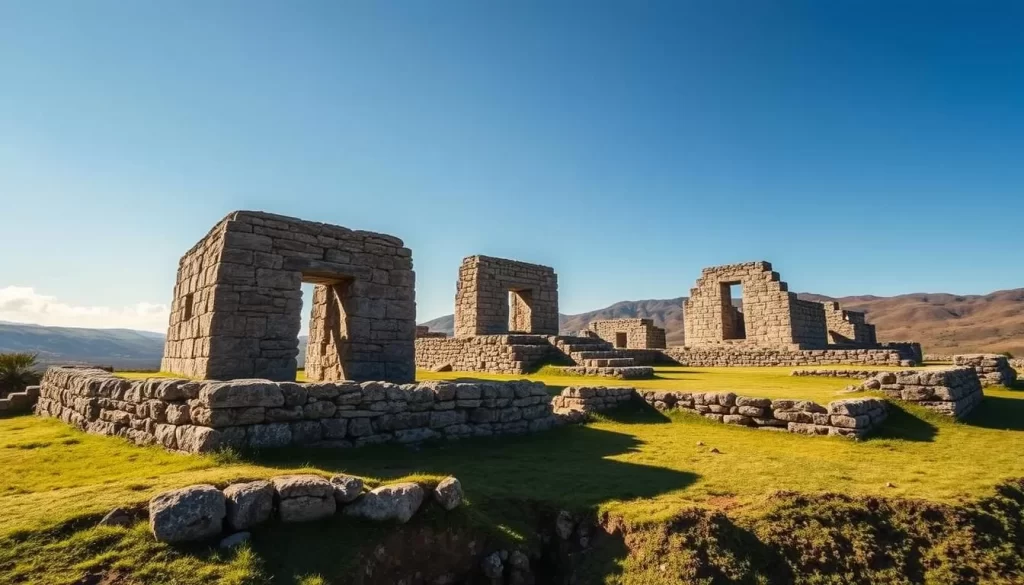
Ingapirca Ruins: Ecuador’s Most Important Inca Site
The Ingapirca Ruins stand as Ecuador’s most significant and well-preserved Inca archaeological site, located about two hours from Cuenca. You can explore the remains of what was once a thriving Inca city before Spanish destruction in the 16th century. The site’s name “Ingapirca” translates to “Inca wall” in Kichwa, reflecting its historical significance.
The precision stonework, particularly in the Temple of the Sun, demonstrates the Incas’ advanced astronomical knowledge and engineering skills. You can easily reach Ingapirca via direct buses from Cuenca’s Terminal Terrestre, making it a convenient day trip with an affordable entrance fee of only $2.
Pumapungo Inca Ruins
Closer to Cuenca, the Pumapungo Inca Ruins behind the Pumapungo Museum offer a free opportunity to explore Inca architecture, including the foundations of buildings, ceremonial areas, and an impressive aqueduct system. This site was once part of the ancient city of Tomebamba, considered one of the most important cities in the northern part of the Inca Empire.
Natural Wonders Around Cuenca
Cuenca is not just about history and culture; it’s also a gateway to some of Ecuador’s most breathtaking natural landscapes. Just a short drive from the city, you can immerse yourself in the great outdoors, exploring national parks and experiencing the region’s diverse ecosystems.
Cajas National Park: A Hiker’s Paradise
Cajas National Park, located just 45 minutes from Cuenca, offers an incredible natural escape with over 200 glacial lakes scattered across a stunning high-altitude landscape at approximately 4,000 meters (13,000 feet) above sea level. The park’s diverse ecosystem encompasses páramo (high-altitude grasslands), cloud forests, and wetlands, creating habitats for unique wildlife including Andean condors, spectacled bears, and over 150 bird species.
Laguna Toreadora provides the most accessible and popular hiking trail in Cajas National Park, perfect for beginners while still offering breathtaking scenery of crystal-clear waters surrounded by rugged mountains. For more adventurous hikers, challenging trails lead to panoramic viewpoints overlooking multiple lakes and valleys.
El Chorro de Girón Waterfalls
About 45 minutes away from Cuenca is the small village of Girón, boasting some very large waterfalls. El Chorro de Girón is a beautiful waterfall and an epic hike that will probably take a full day. You can choose to hike down to the lower level or challenge yourself with the full trail to see all three tiers of waterfalls, with the highest reaching approximately 70 meters (230 feet).
Both Cajas National Park and El Chorro de Girón Waterfalls showcase Ecuador’s incredible biodiversity and geological features, providing a welcome contrast to Cuenca’s urban experiences and giving you a deeper appreciation for the country’s natural wonders. Whether you’re looking for a day trip or a longer adventure, these natural attractions near Cuenca are not to be missed.
Riverside Experiences in Cuenca
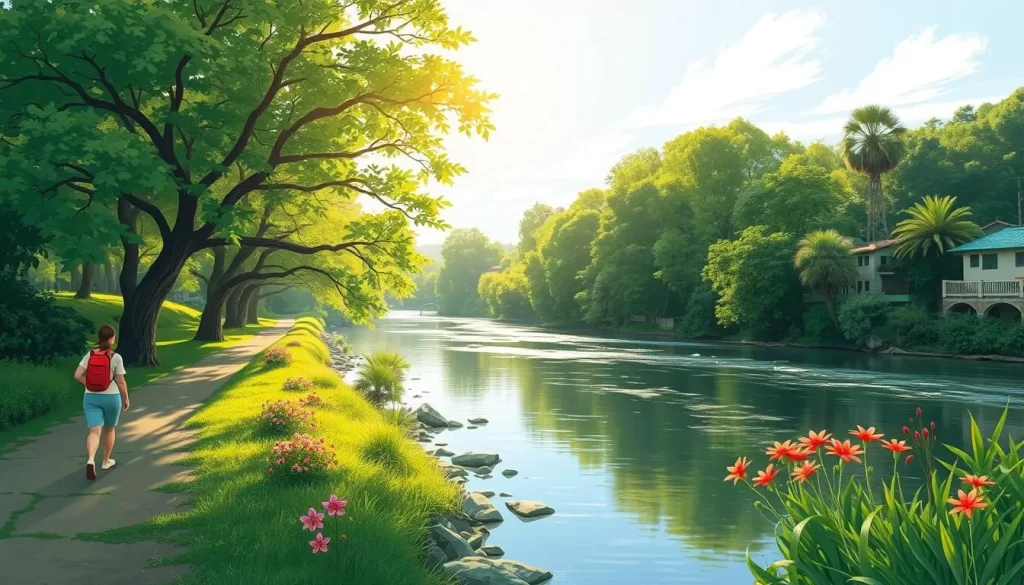
Discover the serene beauty of Cuenca’s Tomebamba River, a perfect spot for a leisurely walk. The river creates a natural dividing line between Cuenca’s historic center and the more modern parts of the city, offering a peaceful retreat from urban bustle just steps away from major attractions.
Tomebamba River Walk
The Tomebamba River is a delightful spot for a stroll, with its grassy riverbanks where locals gather for picnics, reading, or simply relaxing. You can enjoy a leisurely walk along the riverfront, taking in the beautiful scenery. On Sunday mornings, take advantage of the city’s free bicycle program to explore the Tomebamba River path.
Barranco Area: Colonial Architecture Along the River
The Barranco area features some of Cuenca’s most distinctive architecture, with colorful colonial buildings perched dramatically on the cliffs overlooking the Tomebamba River. This picturesque scene is a photographer’s delight, offering a unique glimpse into Cuenca’s rich cultural heritage.
As you stroll along the Tomebamba River, you’ll pass under historic bridges that connect the old and new parts of the city. The riverside path is lined with native trees and flowering plants, creating a green corridor through the city where you might spot local birds and enjoy the soothing sounds of flowing water.
Markets and Shopping in Cuenca
Cuenca’s markets offer a unique shopping experience that showcases the city’s vibrant culture. You can find a variety of local goods, souvenirs, and traditional products that reflect the city’s rich heritage.
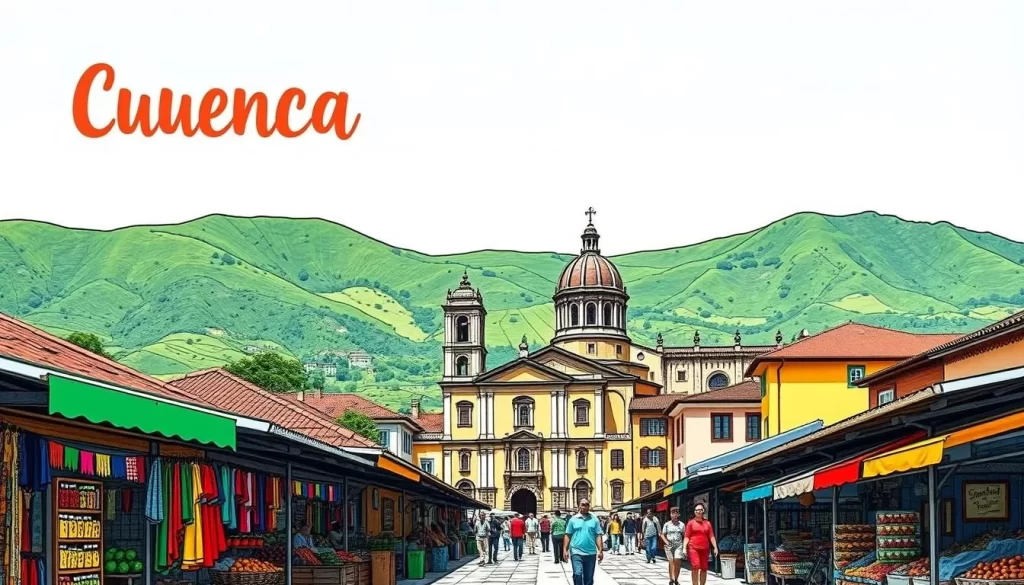
Flower Market (Mercado de las Flores)
The Flower Market, or Mercado de las Flores, is a must-visit destination in Cuenca. Located next to the New Cathedral, this market is renowned for its vibrant displays of flowers, showcasing Ecuador’s position as the world’s third-largest flower exporter. You can admire the beautifully arranged bouquets and exotic blooms at surprisingly affordable prices.
Plaza San Francisco Crafts Market
Just a short walk from the Flower Market, Plaza San Francisco features an iconic “Cuenca” sign, making it a perfect spot for souvenir photos. Beyond the plaza, you’ll discover an extensive crafts market with over 80 shops offering a wide range of goods, including alpaca textiles, Panama hats, and handcrafted jewelry.
10 de Agosto Market
The 10 de Agosto Market provides a more authentic local shopping experience, where you can browse through stalls selling fresh produce, medicinal herbs, and local specialties. This covered market spans several floors and sections, giving you insight into the ingredients that form the basis of Ecuadorian cuisine.
Panama Hat Experience: Cuenca’s Famous Export
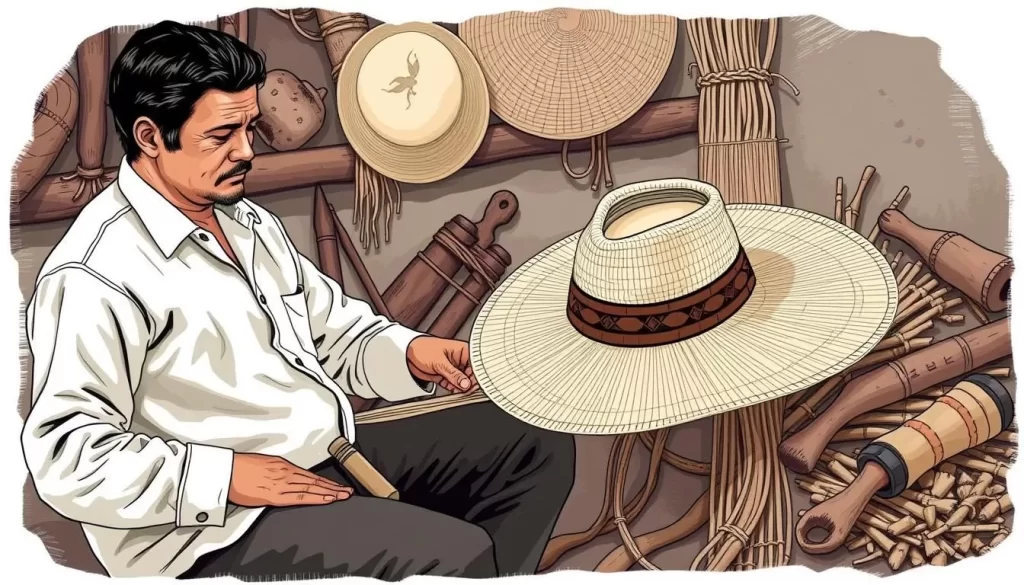
As the world’s leading producer of Panama hats, Cuenca offers a unique opportunity to explore the history and craftsmanship behind these elegant hats. Despite being called “Panama hats,” these iconic accessories are actually made in Ecuador, with Cuenca being the hub of their production and export.
Homero Ortega Panama Hat Museum and Factory
The Homero Ortega Panama Hat Museum and Factory is a must-visit destination for anyone interested in learning about the intricate process of hat-making. Here, you can take a guided tour that walks you through every step, from harvesting and preparing the toquilla straw to the final shaping of the hat. The museum showcases the rich history of this traditional craft, dating back to the 1600s, and displays various styles worn by celebrities and dignitaries.
Shopping for Authentic Panama Hats
When shopping for authentic Panama hats in Cuenca, you’ll find a wide range of options at competitive prices. Places like Homero Ortega and Barrancos Panama Hat Museum offer direct sales, ensuring that you’re buying genuine hats while supporting local artisans. The quality of Panama hats is measured by their fineness of weave, with the finest examples taking up to six months to complete.
Cuenca, Ecuador: Best Things to Do for Wildlife Lovers
If you’re a wildlife enthusiast, Cuenca has plenty to offer, from conservation centers to aviaries featuring native Ecuadorian species. The city is a great base for exploring the surrounding area and its rich biodiversity.
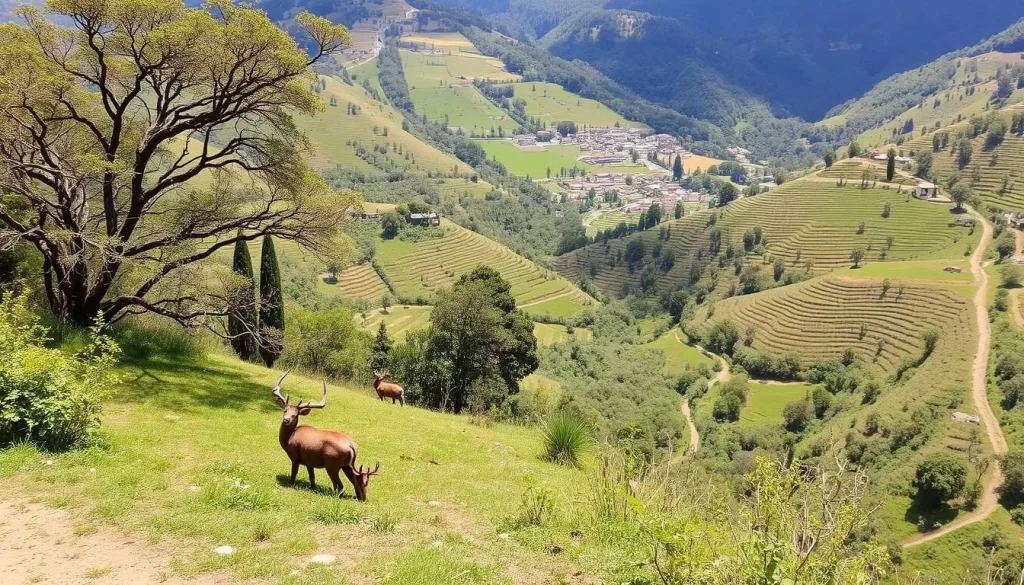
Amaru Biopark: Conservation and Education
Amaru Biopark is a wonderful destination that showcases species primarily native to Ecuador. The park’s layout is designed around the mountains, allowing visitors to see the animals in environments that closely resemble their natural habitats. At Amaru Biopark, you have the chance to see real-life wild animals like jaguars and Andean bears up close.
The park operates as a non-profit wildlife conservation organization focused on rescuing animals from illegal trafficking and providing educational experiences about Ecuador’s biodiversity. Be prepared for a physically demanding visit, as the open-air layout involves a two-hour hike along mountain trails to see all the exhibits.
Pumapungo Aviary
The Pumapungo Aviary, located within the archaeological park behind the Pumapungo Museum, provides a more accessible wildlife experience focused specifically on native bird species of Ecuador. At the aviary, you can observe rescued birds including colorful toucans, parrots, and condors in enclosures designed to mimic their natural habitats.
Both Amaru Biopark and the Pumapungo Aviary contribute to things Cuenca has to offer for wildlife enthusiasts, enhancing the city‘s reputation as a hub for conservation and education.
Traditional Cultural Experiences
Immerse yourself in the traditional cultural experiences that Cuenca has to offer. Cuenca is a city rich in heritage and cultural practices that provide a unique glimpse into the local life.
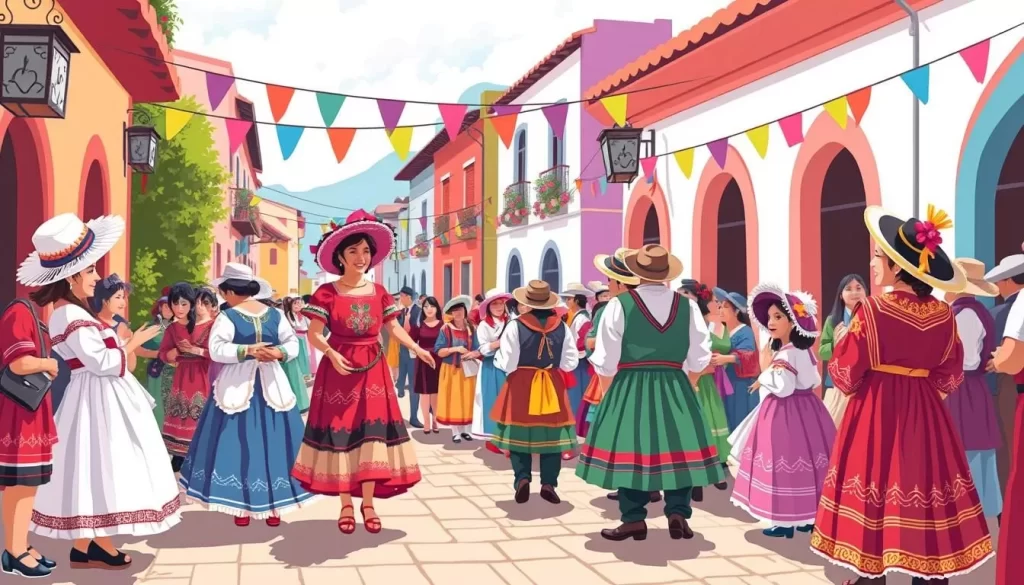
Traditional Healing Ceremony (Limpia)
Experience a traditional healing ceremony called a “limpia” at Cuenca’s markets, where local healers use eggs for diagnosis and create personalized herbal remedies to cleanse your energy and treat various ailments for just $3. These ceremonies typically take place on specific days at the 10 de Agosto Market.
Casa de la Makana: Traditional Weaving
At Casa de la Makana, you can observe the ancient art of traditional weaving as artisans create vibrant “ikat” textiles using techniques passed down through generations. The museum offers demonstrations of the entire process, from dyeing threads with natural pigments to weaving on traditional wooden looms.
Free Walking Tours of Cuenca
Free walking tours provide an excellent introduction to Cuenca, typically lasting about three hours and covering major attractions while sharing insider knowledge about the best restaurants, hidden gems, and local customs. Though advertised as “free,” these tours operate on a tip-based model.
By participating in these cultural experiences, you not only enrich your travel experience but also contribute to the preservation of traditional knowledge and crafts that might otherwise be lost. You will gain authentic connections with locals and deeper insights into Cuencano traditions that have survived for centuries.
Culinary Adventures in Cuenca
Embark on a gastronomic journey through Cuenca, where local cuisine showcases the region’s agricultural bounty.
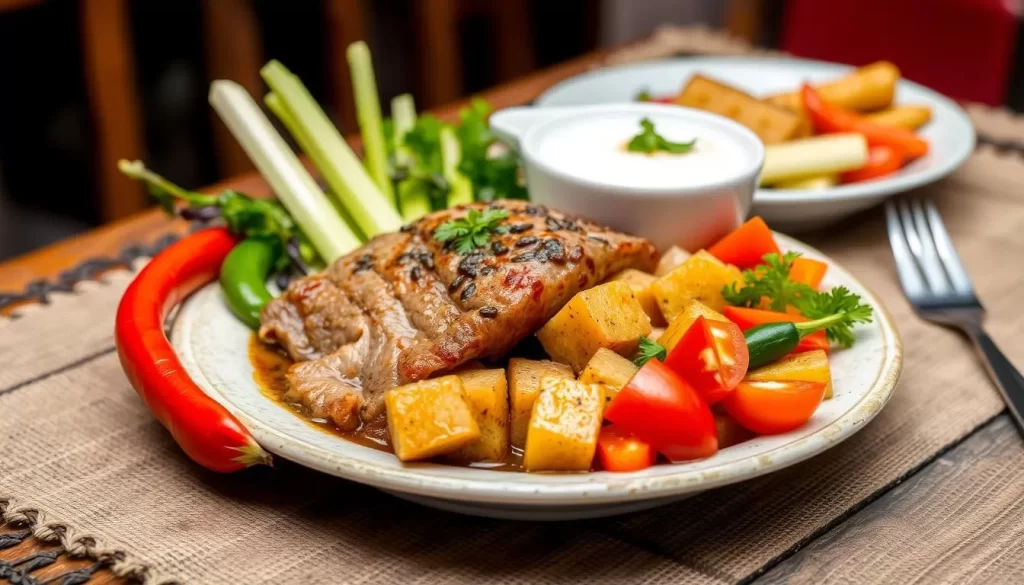
Must-Try Local Dishes
Cuenca offers a diverse culinary scene where you can sample authentic Ecuadorian dishes that showcase the region’s agricultural bounty and cultural influences at surprisingly affordable prices. One must-try local specialty is hornado, featuring whole roasted pig with incredibly juicy meat and crispy skin, typically served with mote (hominy corn), llapingachos (potato patties), and a variety of fresh vegetables for around $3-5 per plate.
For a truly local experience, visit the 10 de Agosto Market, an authentic place to sample traditional foods including locro de papa (potato soup with cheese and avocado) and fresh tropical fruits that you may never have encountered before.
Trying Cuy (Guinea Pig): Ecuador’s Traditional Delicacy
For the adventurous eater, cuy (guinea pig) represents an important traditional delicacy in Andean cuisine. Salon Tres Estrellas is the premier place in Cuenca to try this dish prepared in the authentic style over hot coals. When ordering cuy, be aware that you’ll need to reserve about an hour in advance as each one is prepared to order, resulting in crispy skin similar to pork cracklings and tender meat that tastes somewhat like rabbit.
Street Food Experiences
Cuenca’s street food scene offers delicious quick bites that give you a taste of everyday local cuisine. Be sure to try salchipapas (french fries topped with sausage), empanadas de viento (cheese-filled pastries), and morocho (sweet spiced corn drink). For a sweet treat, indulge in espumilla (a colorful meringue-like dessert topped with sprinkles) and huevitos chilenos (similar to donut holes).
Best Restaurants and Cafés in Cuenca
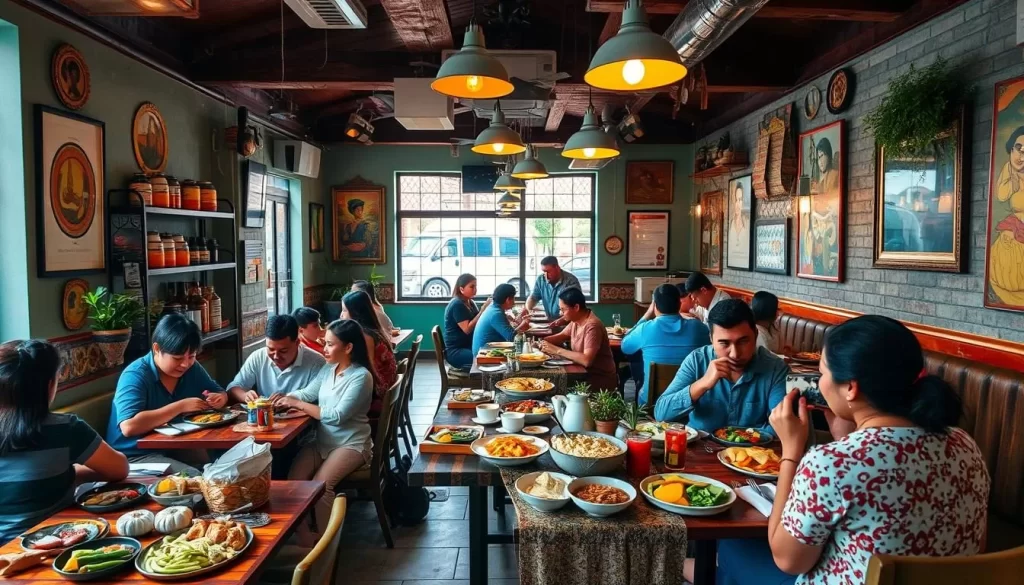
Cuenca’s restaurants have gained a reputation for serving some of the finest cuisine in Ecuador, blending traditional flavors with international twists. The city’s dining scene has flourished over the past decade, offering a diverse range of options to suit various tastes.
Traditional Ecuadorian Restaurants
For an authentic Ecuadorian experience, head to Guajibamba, a renowned restaurant that specializes in traditional dishes, including the famous cuy (guinea pig). The waitstaff are attentive and happy to explain the preparation process, making it a unique cultural experience. You can also explore Seminario San Luis, a charming plaza next to the New Cathedral, which offers reasonably priced meals in a picturesque setting.
International Dining Options
Cuenca’s dining scene is not limited to traditional Ecuadorian cuisine. You can also find international flavors, such as French cuisine at Le Petit Jardin, innovative fusion at Anima Cocina de Autor, and Belgian food and craft beer at Jodoco Belgian Brew. These restaurants offer a great alternative for those looking to try something different.
Café Culture in Cuenca
The city’s café culture has been enriched by expats, resulting in cozy establishments like San Sebas Café, where you can enjoy hearty breakfasts, comfort food, and community events. Many restaurants in Cuenca’s historic center are housed in beautifully restored colonial buildings, creating unique dining atmospheres that combine architectural heritage with culinary excellence.
Day Trips from Cuenca
If you’re looking for adventure or relaxation, the day trips from Cuenca have got you covered. The region surrounding Cuenca is rich in cultural heritage and natural beauty, offering a variety of exciting experiences.
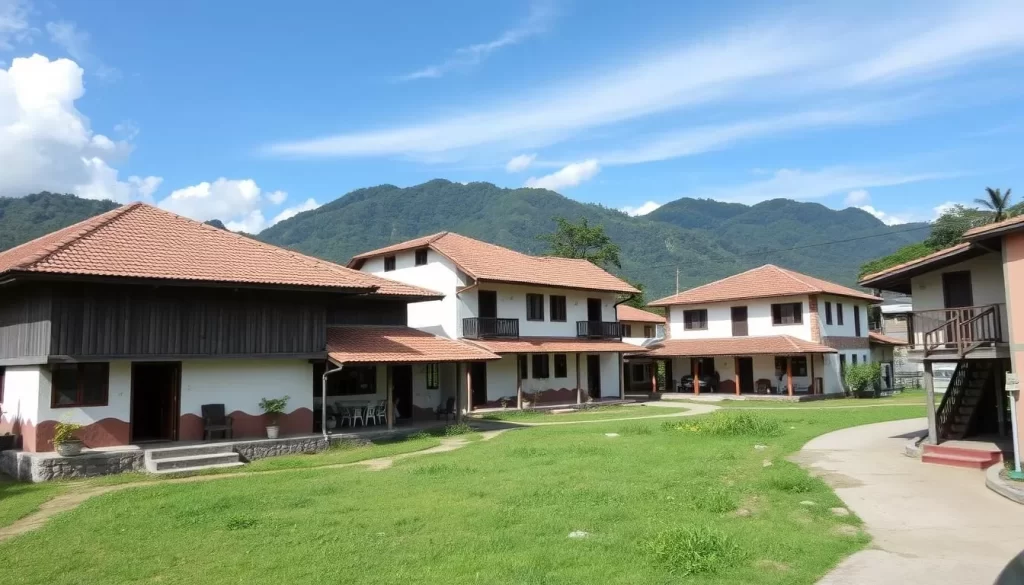
Gualaceo, Chordeleg, and Sigsig Villages
The artisan villages of Gualaceo, Chordeleg, and Sigsig are perfect for a day trip, located just 30-45 minutes away from Cuenca. Here, you can witness skilled craftspeople creating beautiful jewelry, textiles, and woodwork using traditional techniques. Gualaceo is renowned for its colorful textiles and vibrant Sunday market, while Chordeleg specializes in exquisite gold and silver filigree jewelry. Sigsig, on the other hand, is famous for its authentic Panama hat production.
As you travel along the way to these villages, you’ll pass through picturesque countryside with small farms, orchards, and river valleys that showcase rural Ecuadorian life outside the city. This day trip offers a unique blend of cultural immersion and artisanal shopping, making it an ideal excursion for those looking to experience the authentic essence of Ecuador.
Piedra de Agua Hot Springs and Spa
For a relaxing day trip, consider visiting Piedra de Agua Hot Springs and Spa, located just a short distance from Cuenca. Soak in the natural thermal pools, enjoy mud baths, and indulge in spa treatments at prices significantly lower than you’d find in North America or Europe. The facility is open until 11 PM, making it perfect for an evening visit after a day of sightseeing. Weekday visits are especially peaceful as few tourists know about this hidden gem.
Giron and El Chorro Waterfall
Nature lovers will enjoy a day trip to Girón and El Chorro Waterfall, about 45 minutes from Cuenca. The El Chorro waterfall trail offers options for different fitness levels, from a relatively easy walk to the lower falls to a more challenging full-day hike to see all three tiers of this spectacular natural attraction. The scenic beauty of the area, with lush green mountainsides and impressive cascades, makes for an unforgettable experience.
These day trips from Cuenca showcase the diverse experiences available within easy reach, from cultural immersion and artisanal shopping to natural wonders and relaxation. You can customize your excursions based on your interests, ensuring a memorable trip to this beautiful region of Ecuador.
Practical Information for Visiting Cuenca
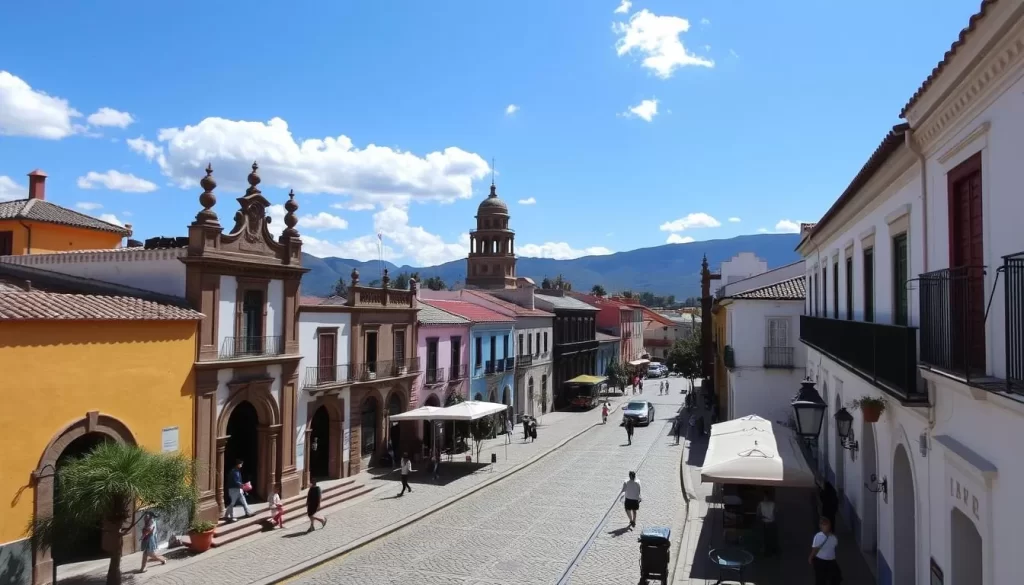
To ensure a smooth and enjoyable trip to Cuenca, Ecuador, understanding the practical details is crucial. Whether you’re arriving by air or land, knowing your options for getting to and around Cuenca will help you plan your trip effectively.
Getting to Cuenca
Cuenca is accessible by both air and land. By air, you can take a domestic flight from Quito or Guayaquil. Flights from Quito to Cuenca take around 30 minutes, while flights from Guayaquil take about an hour. Cuenca’s Mariscal Lamar International Airport is well-connected to Ecuador’s major airports, making it easy to reach this cultural gem.
For those on a budget or with more time, traveling by bus is a viable option. The bus journey from Guayaquil takes approximately four hours, while from Quito, it takes around eight hours. Comfortable buses traverse scenic mountain roads, offering a picturesque view of the Ecuadorian landscape.
Getting Around the City
Once in Cuenca, you’ll find that the historic center is perfectly designed for walking. Most major attractions are within a compact area, allowing you to explore at a leisurely pace while appreciating the architectural details. Taxis are also abundant and affordable, with most rides within the city costing between $1.50-$3. Just ensure that the driver uses the meter to avoid overcharging.
Safety Tips
Cuenca is considered one of the safest major cities in Ecuador. However, standard travel precautions still apply. Keep your valuables secure, use hotel safes for important documents, and avoid displaying expensive electronics or jewelry in public areas.
Altitude Considerations
Cuenca sits at an altitude of approximately 2,550 meters (8,366 feet), which can cause mild altitude sickness for some visitors. To acclimate, plan to take it easy on your first day and stay well-hydrated. If you’re sensitive to altitude, consider taking preventative supplements or bringing altitude sickness medication.
By being aware of these practical details, you can focus on enjoying the rich cultural heritage and natural beauty that Cuenca has to offer.
Conclusion: Why Cuenca Should Be on Your Ecuador Itinerary
Cuenca’s unique blend of history, culture, and natural beauty makes it an ideal travel spot. As we’ve explored, Cuenca, Ecuador, offers an unparalleled travel experience, combining affordability, rich cultural heritage, and stunning landscapes that make it a top destination for travelers and those looking to settle down.
The city’s UNESCO World Heritage status is a testament to its well-preserved Spanish colonial architecture, creating an atmosphere that transports you back in time. Cuenca remains remarkably affordable for travelers, with excellent accommodations, dining, and activities available at prices that will pleasantly surprise most international visitors.
One of the best things about Cuenca is its compact size, allowing you to experience a diverse range of attractions without spending excessive time on transportation. As Ecuador’s cultural capital, Cuenca boasts a vibrant arts scene, numerous museums, and regular cultural events that provide deeper insights into Ecuadorian heritage.
The surrounding region offers incredible diversity within easy reach—from Andean highlands and national parks to indigenous villages and archaeological sites. This diversity, coupled with Cuenca’s pleasant year-round climate, makes it an ideal destination for travelers looking to experience the best of South America without the hassle of constant travel.
Whether you’re a solo traveler, couple, family, or retiree, Cuenca’s welcoming atmosphere, safety record, and variety of activities make it one of the best things to include in any Ecuador travel plan. With its unique blend of colonial charm, natural beauty, and cultural richness, Cuenca is undoubtedly one of the best places to visit in all of South America, making it a must-include in your travel itinerary.
The above is subject to change.
Check back often to TRAVEL.COM for the latest travel tips and deals.
